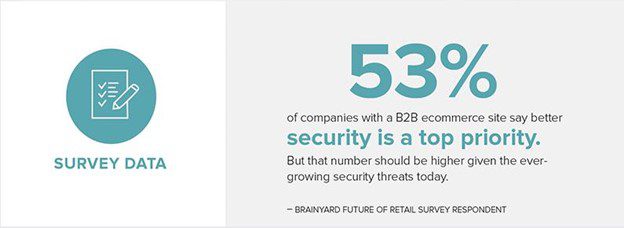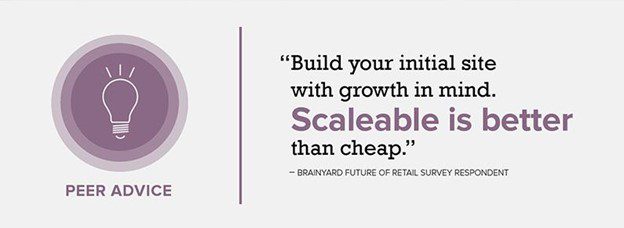Launching an eCommerce program requires an investment in human and financial resources, but the return promises to more than recoup that outlay. More importantly, ignoring an online sales channel could soon come at a steep cost: A downturn in revenue as more buyers take their business to competitors with an online presence. More than 95% of B2B and B2C companies responding to a recent Brainyard survey on the future of retail have eCommerce sites. Of those, 51% have had online stores for five-plus years, and an additional 23% launched their sites at least two years ago. Although in-store purchases represent the majority of retail sales, for business-to-business (B2B) organizations, online is where the growth is.
Our advice: An omnichannel approach of selling through retail channels and third-party ecommerce sites can unlock the next level of growth.
For those trailing in their ecommerce efforts, we’ll walk through a timeline for a fictional organization preparing to launch a B2B ecommerce site in this article. If you’ve exclusively sold online to consumers and are trying to break into wholesale distribution, watch for our companion piece later this month.
Meet Wally’s Wood Distributors
Wally Smith started his wood distribution company 25 years ago in Tacoma, Wash., selling both standard lumber and exotic woods from around the globe. Smith sources his product from foresters and primarily sells to furniture makers and artists who use the material to build their pieces. Today, Wally’s Wood Distributors employs about 80 people.
For most of the business’ history, Wally saw no need for a website. Over the years, he’s built strong relationships with furniture companies and artists who submit their orders via phone, email, or fax. Four years ago, Wally’s oldest son, Will, joined the company and convinced his father to create an informational website so more potential customers could discover Wally’s Wood Distributors. Two years after creating the site, many clients say it would be great if they could access real-time inventory and order history data and manage their purchases online.

Will sees a big opportunity to provide that information and sell products with an online sales channel like an ecommerce site. Wally was initially skeptical, but his son showed him statistics about the swift growth of B2B ecommerce and pointed out that several competitors already have full-service sites. The tipping point came when fellow executives told Wally that starting this online sales channel was vital to the company’s future success. The owner assigns his son to head up the project.
What now?
We’ve broken down a comprehensive plan into five key milestones, with the idea that the company’s CFO could budget over five fiscal years to achieve a robust ecommerce presence. Some companies may move more quickly or more slowly. Let’s get started.
Year 1: Start a Marketplace, Select a Platform
Meet with people across the organization, including sales, marketing, finance, IT, operations, and human resources, to explain the initiative and address concerns. In another effort to encourage buy-in, he leads several companywide meetings outlining the project and its reasoning. Will and his father even recorded a two-minute video explaining why they believe and online sales channel will help the business grow.
Around that same time, Will researches B2B ecommerce consultants — outsourcing is less expensive than hiring someone with the right experience — and reaches out to industry peers for recommendations. He eventually finds a consultant, Hannah, who’s worked in ecommerce for 15 years and focused on B2B ecommerce for the last five years. Hannah agrees to help the company map out its initial ecommerce strategy.
Hannah’s first suggestion is that Wally’s Wood should start on a large B2B marketplace like Amazon Business before creating its site. She points out that the time-to-market is much faster for an established marketplace, and that route avoids some of the challenges of launching an independent online store. The infrastructure and traffic already exist, so the distributor must only open an Amazon Business storefront and pull together the required product data.
Wally’s Wood will use Fulfillment by Amazon, meaning the wood distributor’s products are stored at Amazon warehouses, and the ecommerce giant handles fulfillment and shipping. The distributor must abide by Amazon’s detailed regulations, but in return, Will can get a few hundred products live on Amazon in less than six months. It’s a quick win and a proven way to break into ecommerce.
With this first foray into ecommerce complete, Will and Hannah launch a dedicated ecommerce site. First, Will collects links to several B2B eCommerce sites he likes, and then he collaborates with Hannah and his staff to build a consensus around two sites to use as loose templates. After that, Will reaches out to some of the customers who expressed interest in ecommerce, asking if they will join an advisory panel to help shape the online sales channel strategy for Wally’s Wood and determine the most important features and products.

After writing up business goals and functional requirements for the site, including required integrations, Will, Hannah, and the executive team book initial sales calls with four different ecommerce solution vendors, that team quickly narrows the list to two platform providers and sets up several follow-up calls and an on-site demo with each.
As Year 1 concludes, Wally’s Wood identifies the winning provider. The chosen ecommerce platform has a strong track record integrating with the company’s ERP system and creating B2B ecommerce sites.
Year 2: Find a Developer and Go Live
The next step is finding someone to design and build the site. Will has two options: Hire a third-party developer or assemble a dedicated one- or two-person internal team. Hannah cautions against simply passing the project off to someone in marketing; she knows from experience that this is likely to overwhelm employees with little background in ecommerce.
Given that ecommerce is a still-unproven endeavor for the business, Will decides to go with a third party, a less expensive option.
Will discovers that overseas site developers cost less initially, but peers point out that offshoring presents major challenges around language barriers and time-zone differences. So Wally’s Wood decides on a U.S. developer, Digital B2B Experts Inc., with a strong track record developing for Will’s chosen ecommerce platform.
Digital B2B Experts work with Will and company executives to create a statement of work with a detailed timeline. The developer suggests selling 500 to 750 SKUs online so Will’s team can handle the amount of data they must develop for each product. Wally’s Wood uses a combination of feedback from the customer panel and sales analytics to determine what those items should be and eventually selects 650 SKUs.
A few months later, Digital B2B Experts started sending Will mock-ups of site pages for feedback, suggesting ways to make the site mobile-device friendly. The business makes several design tweaks, often going through two or three rounds of edits before approving the pages. Meanwhile, Will assigns one member of the marketing team to build out product content, like specs, product descriptions, and images, for those 650 SKUs.
At the same time, Will and Digital B2B Experts begin mapping out integrations between Wally’s Wood Distributors’ ecommerce software, its ERP suite, including accounting and order/inventory management, and its customer relationship management (CRM) system. These integrations are necessary to support crucial features of a B2B ecommerce site, like customer-specific pricing, real-time inventory, quoting, payment on credit terms, and purchase orders. Once that works, employees start testing the site to identify bugs, missing features, and broken integrations. That’s followed by a beta test led by a select group of customers.

Before opening the site so people can start placing orders, Wally’s Wood must ensure its site is secure. The company chose an ecommerce platform compliant with the latest Payment Card Industry Data Security Standard, per Hannah’s recommendation (PCI compliance is a must to accept credit cards). Will also wants the site to have an HTTPS URL, so he purchases an Extended Validation SSL certificate. Once this is in place, browsers will show a closed lock symbol in the address bar rather than a disconcerting “Not Secure” message.
Finally, Wally’s Wood has a third party perform a security audit of the near-finished site. To stay in line with best practices for security, Will plans to do this every year.
Right around the two-year mark, the site goes live, and customers start placing orders. While the product catalog with detailed information is available for anyone, clients must have an account and log in to see pricing and check out. The company works through a few minor issues related to fulfillment and shipping at its warehouse, but the go-live is largely successful.
The business continues to sell on Amazon, using Fulfillment by Amazon to keep inventory management as straightforward as possible. Launching a new channel is already a big undertaking, so Will wants to maintain the status quo on Amazon Business.
Year 3: Optimize the Customer Experience
With the ecommerce site live, Will focuses on drumming up internal and external support. To ensure the site has sales backing, account executives earn commission on online orders at the same rate they do for sales through other channels. Wally schedules a meeting with all the reps to reiterate that this ecommerce site is critical to the future of Wally’s Wood and that sales play a key role in driving adoption.
The sales team has two months to contact all the accounts they oversee. They are tasked with explaining how customers can register for accounts, running through the basics of how the site works — searching, payment options, and the checkout process; and addressing any questions and concerns. Finally, reps can give all clients a promotion code for 15% off their first online orders, valid for six months. A few weeks later, the business sends an email campaign to its database promoting the new site with that same discount.
The next step is to improve the online customer experience. Hannah, the consultant, suggests Wally’s Wood start by adding more images and enhancing the ability of visitors to find just the right product. To improve site search, Will’s team must ensure all products have the most relevant keywords and tags. Marketing looks at Google Analytics data from its site to see what terms customers typically use to look for items that go by multiple names.
In addition, Wally’s Wood adds a faceted search that lets visitors narrow their results by such metrics as size, country of origin, type of Wood, and price per board foot. The marketer who built out product content standardized most product specs (14 inches, not 14 in. or 14″). Still, Will’s team finds and fixes a few outliers in the product catalog to ensure the faceted search will work properly.
Once that’s done, the organization focuses on SEO. Will relies on Hannah’s expertise as well as Google Trends and Google Search Console to identify top transactional keywords for wholesale Wood, then figure out the best ways to rank for them. That includes adjusting product titles and descriptions as well as optimizing metadata.
Year 4: Expand the Catalog, Give Customers Options
Now it’s time to focus on refining the customer experience with the assistance of Digital B2B Experts. Wally’s Wood reorganizes navigation menus after multiple clients suggest a more logical way to group SKUs. It also adds a “Recommended Products” section on the bottom of the product detail pages to increase cross-sells and a “Request for Quote” feature so a customer can price out an order and see their tax bill before placing items in the cart.
Will’s vision for this ecommerce site has become a reality, and sales have more than doubled 18 months after go-live. A growing contingent of customers ask why some products are not available online, so Will and other stakeholders decide it’s time to expand the online product catalog.
Wally’s Wood has more than 2,000 SKUs, many of those different sizes of the same types of woods and a variety of cuts, and its primary goal this year is to get all of them online. Thanks to the site’s rapid growth, Will can now dedicate three people to ecommerce. They start compiling product data for the 1,400 SKUs that are still available online.
The organization also creates informational pages about its wood-finishing and -cutting services. This services division accounts for only about 10% of revenue, but Will is hopeful that featuring it online will encourage more customers to try it. As part of this effort, the ecommerce team adds options for upsell finishing or cutting services to the product detail pages for its most popular woods.
Wally’s Wood sales reps want more insights into how their customers use the ecommerce site, so the team adds a customer intelligence solution that tracks what customers look at online, any items they put in their carts, and what content they download. This solution is an excellent tool for gathering insights that reps can use to start relevant and timely conversations with artists and furniture makers.
Year 5: Explore New Opportunities
Wally’s Wood zeroes in on operational improvements in Year 5. It wants to speed up fulfillment and offer buyers more delivery options. The company evaluates every step of the process, from when an order comes into the warehouse to when it ships and finds ways to make picking and packing more efficient. Those improvements help the company ship 90% of orders same-day if they’re placed by 4 p.m., an important move in the age of super-fast delivery. It also offers customers more options, including expedited shipping for an additional fee and next-day pick-up at its warehouse for local buyers.

Almost three years after the site went live, it accounts for nearly 20% of sales. With that data, Will gets Wally and the other executives on board with increasing its product selection on Amazon Business and selling through other third parties — maybe even some specialty brick-and-mortar retailers. The ecommerce team finds a niche marketplace for B2B distributors that targets homebuilders and carpenters. Though it gets far less traffic than Amazon, more visitors have real potential to become customers.
If the ecommerce business continues to perform well over the next year or so, Will plans to look into starting a direct-to-consumer online sales channel. He’s noticed a lot of other B2B brands jumping into B2C and thinks it could be the next big step for Wally’s Wood in its ecommerce journey. But for now, Will and his father are simply proud of how far the company has come over the last five years.
Nailing Down Multi-Channel Retail
As outlined here, building a new sales channel from the ground up requires time, energy, money, and support from across the organization. However, as customer expectations continue to evolve in both the B2B and B2C worlds, selling through multiple channels is increasingly a requirement rather than an option.
Beyond that, companies must find creative ways to link those channels, a proven way to build customer loyalty. Options like “buy online, pick up in-store” or placing an online order in-store for a product that’s not currently available are two examples of that linkage. They might even develop a way to sell personalized cutting or finishing services. Allowing customers to purchase items through multiple channels is a big step in the right direction, but only the first move in a business reinventing itself to stay relevant in the years to come.













